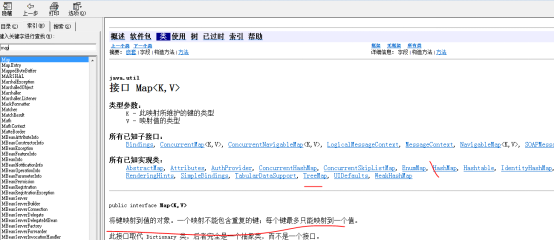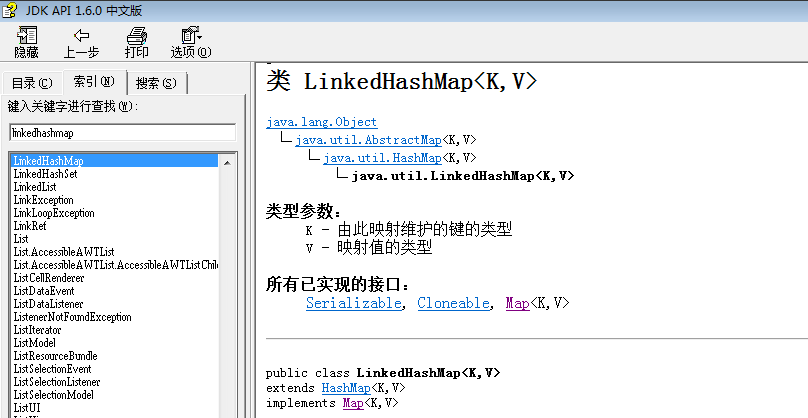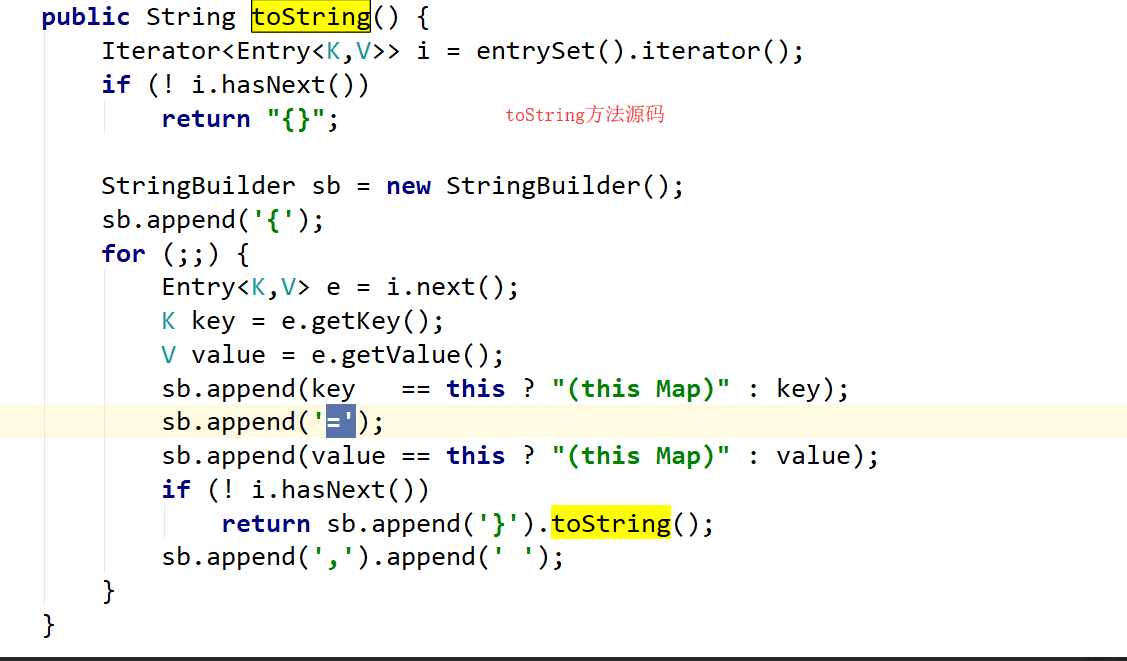1 Map集合
1.1 Map集合概述和特点
* A:Map接口概述
* 查看API可以知道:
* 将键映射到值的对象
* 一个映射不能包含重复的键
* 每个键最多只能映射到一个值
* B:Map接口和Collection接口的不同
* Map是双列的,Collection是单列的
* Map的键唯一,Collection的子体系Set是唯一的
* Map集合的数据结构(hash算法)只针对键有效,跟值无关;Collection集合的数据结构是针对元素有效

1.2 Map集合的功能概述
* A:Map集合的功能概述
* a:添加功能
* V put(K key,V value):添加元素。
* 如果键是第一次存储,就直接存储元素,返回null
* 如果键不是第一次存在,就用值把以前的值替换掉,返回以前的值
* b:删除功能
* void clear():移除所有的键值对元素
* V remove(Object key):根据键删除键值对元素,并把值返回
* c:判断功能
* boolean containsKey(Object key):判断集合是否包含指定的键
* boolean containsValue(Object value):判断集合是否包含指定的值
* boolean isEmpty():判断集合是否为空
* d:获取功能
* Set<Map.Entry<K,V>> entrySet():拿到所有的键值对象。后面说
* V get(Object key):根据键获取值
* Set<K> keySet():获取集合中所有键的集合
* Collection<V> values():获取集合中所有值的集合
* e:长度功能
* int size():返回集合中的键值对的个数
package com.jhedu.day19; import java.util.HashMap; import java.util.Map; import java.util.Set; public class Demo1_Map { public static void main(String[] args) { demo3(); } public static void demo3() { Map<String, Integer> map = new HashMap<>(); // 返回的值是被覆盖的内容 // 第一次加入时,集合中并没有任何内容,被覆盖的内容为null,所以返回值时null //Map的底层依赖于set,还是set的顶层依赖于Map map.put("a",1); map.put("b",2); map.put("c",3); map.put("d",4); map.put("e",5); boolean b = map.containsKey("a"); boolean b1 = map.containsKey("f"); System.out.println(b + "..." + b1); boolean b2 = map.containsValue(1); boolean b3 = map.containsValue(7); System.out.println(b2 + "..." + b3); map.clear(); System.out.println(map.isEmpty()); } public static void demo2() { Map<String, Integer> map = new HashMap<>(); // 返回的值是被覆盖的内容 // 第一次加入时,集合中并没有任何内容,被覆盖的内容为null,所以返回值时null //Map的底层依赖于set,还是set的顶层依赖于Map map.put("a",1); map.put("b",2); map.put("c",3); map.put("d",4); map.put("e",5); // map.clear(); // 打印集合时,只有输出的内容不是类名 + "@" + 16进制的地址值, // 就说该集合重写了Object类的toString方法 System.out.println(map.size() + "..." + map); Integer i = map.remove("a"); System.out.println(i); System.out.println(map); } public static void demo() { Map<String, Integer> map = new HashMap<>(); // 返回的值是被覆盖的内容 // 第一次加入时,集合中并没有任何内容,被覆盖的内容为null,所以返回值时null //Map的底层依赖于set,还是set的顶层依赖于Map Object b = map.put("a",1); Object b1 = map.put("b",2); Object b2 = map.put("c",3); Object b3 = map.put("d",4); Object b4 = map.put("e",5); System.out.println(map); System.out.println(b + " " + b1 + " " + b2 +" " + b3 + " " + b4); } }
1.3 Map集合的遍历之键找值
keySet 返回的是一个Set 集合,set中有迭代器。再调用get方法

public static void demo4() { Map<String, Integer> map = new HashMap<>(); // 返回的值是被覆盖的内容 // 第一次加入时,集合中并没有任何内容,被覆盖的内容为null,所以返回值时null //Map的底层依赖于set,还是set的顶层依赖于Map map.put("a",1); map.put("b",2); map.put("c",3); map.put("d",4); map.put("e",5); Integer i = map.get("a"); /** * 分析: * 1. Map中可以通过键获取对应的值 ( Integer i = map.get("a");) * 2. 遍历Map时需要首先获得所有键的集合 (Set<String> set = map.keySet()) * 3. 使用Iterator迭代器遍历上述Set集合 * 4. 通过Map的键以及get方法可以获取对应的值 */ Set<String> set = map.keySet(); Iterator<String> it = set.iterator(); while(it.hasNext()){ // 判断集合中是否有元素 String key = it.next(); // 取到集合中对应的键 Integer value = map.get(key) ; System.out.println(key + "...." + value); } }
1.4 Map集合的遍历之键值对对象找键和值
* A:键值对对象找键和值思路:
* 获取所有键值对对象的集合
* 遍历键值对对象的集合,获取到每一个键值对对象
* 根据键值对对象找键和值
* B:案例演示
* Map集合的遍历之键值对对象找键和值
package com.se.Map; import java.util.HashMap; import java.util.Iterator; import java.util.Map; import java.util.Set; public class Demo04_Test { public static void main(String[] args) { HashMap<String, Integer> map = new HashMap<>(); map.put("张三", 23); map.put("李四", 24); map.put("王五", 25); map.put("赵六", 26); //通过map的keySet()方法 Set<String> set = map.keySet(); Iterator<String> iterator = set.iterator(); while (iterator.hasNext()){ String key = iterator.next(); Integer value = map.get(key); System.out.println(value); } for (String s : set) { Integer value = map.get(s); System.out.println(value); } //通过map的entrySet()方法 Set<Map.Entry<String, Integer>> entrySet = map.entrySet(); //获取所有的键值对象的集合 Iterator<Map.Entry<String, Integer>> iterator = entrySet.iterator(); //获取迭代器 while (iterator.hasNext()) { Map.Entry<String, Integer> en = iterator.next(); //获取键值对对象 String key = en.getKey(); //根据键值对对象获取键 Integer value = en.getValue(); //根据键值对对象获取值 System.out.println(key + "..." + value); } for (Map.Entry<String, Integer> en : map.entrySet()) { System.out.println(en.getKey() + "=" + en.getValue()); } } }
1.5 HashMap集合键是Student 值是String的案例
* A:案例演示
* HashMap集合键是Student值是String的案例
HashMap<Student, String> hm = new HashMap<>();
hm.put(new Student("张三", 23), "北京");
这里面的键相当于hashSet里面的元素 hashSet要求如果是自定义对象必须重写hashcodehe equals方法
package com.se.Map; import java.util.HashMap; public class Demo03_Map { public static void main(String[] args) { // 当map集合中键值为自定义对象时,我们必须重写equals方法和hashCode方法 HashMap<Student, String> map = new HashMap<>(); map.put(new Student("张三",20),"焦作"); map.put(new Student("李四",18),"许昌"); map.put(new Student("王五",16),"漯河"); System.out.println(map); String address = map.get(new Student("王五", 16)); System.out.println(address); } }
2 LinkedHashMap的概述和使用
* A:案例演示
* LinkedHashMap的特点
* 底层是链表实现的可以保证怎么存就怎么取

package com.jhedu.day19; import java.util.LinkedHashMap; import java.util.Map; public class Demo4_LinkedHashMap { public static void main(String[] args) { Map<String, Integer> map = new LinkedHashMap<>(); map.put("张三",23); map.put("李四",24); map.put("王五",25); map.put("赵六",26); System.out.println(map.toString()); } }

2.1 TreeMap集合键是Student值是String的案例
package com.jhedu.day19; import java.util.*; public class Demo5_TreeMap { public static void main(String[] args) { //2. 比较器排序 或者重写comparator接口下的compare方法 TreeMap<Student, String> map = new TreeMap<>( new Comparator<Student>() { @Override public int compare(Student o1, Student o2) { int num = o1.getName().compareTo(o2.getName()); return num==0?o1.getAge()-o2.getAge():num; } } ); map.put(new Student("张三", 23),"北京"); map.put(new Student("张三",23), "北京"); map.put(new Student("李四",24),"上海"); map.put(new Student("王五",25),"广州"); map.put(new Student("赵六",26),"深圳"); map.put(new Student("张三",23), "郑州"); for(Map.Entry<Student,String> s: map.entrySet()){ System.out.println(s.getKey() + "..." + s.getValue()); } } public static void demo2() { // 1. 字典顺序排序:当TreeSet集合中的键是自定义对象时,必须重写comparable接口下的compareTo方法 TreeMap<Student, String> map = new TreeMap<>(); map.put(new Student("张三", 23),"北京"); map.put(new Student("张三",23), "北京"); map.put(new Student("李四",24),"上海"); map.put(new Student("王五",25),"广州"); map.put(new Student("赵六",26),"深圳"); map.put(new Student("张三",23), "郑州"); System.out.println(map); } public static void demo1() { TreeMap<String, Integer> map = new TreeMap<>(); // 返回的值是被覆盖的内容 // 第一次加入时,集合中并没有任何内容,被覆盖的内容为null,所以返回值时null //Map的底层依赖于set,还是set的顶层依赖于Map map.put("d",4); map.put("e",5); map.put("a",1); map.put("b",2); map.put("c",3); System.out.println(map); // TreeMap会按照键的字典顺序进行排序 } }
2.2 HashMap和Hashtable的区别
* A:面试题
* HashMap和Hashtable的区别
* Hashtable是JDK1.0版本出现的,是线程安全的,效率低,HashMap是JDK1.2版本出现的,是线程不安全的,效率高
* Hashtable不可以存储null键和null值,HashMap可以存储null键和null值